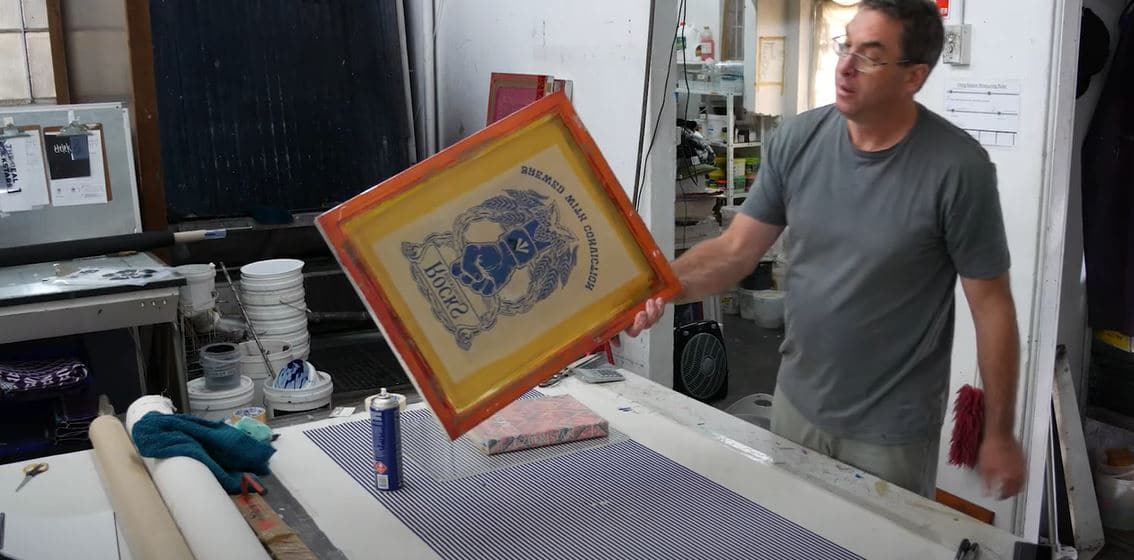The Important Overview to Comprehending Screen Printing and Its Versatile Utilizes
Screen printing has a rich background that goes back to old times, progressing into an advanced technique made use of throughout various industries today. This guide discovers the details of the screen printing process, detailing its applications in marketing, style, and home design - 10:9 Design reviews. Understanding these fundamentals can open imaginative possibility for both imaginative and business projects. The complying with sections will expose important ideas and strategies to enhance one's screen printing undertakings
The Background of Screen Printing
Although screen printing has origins that trace back centuries, its evolution shows the imaginative and technical innovations of numerous societies. Coming from ancient China, the technique was originally made use of for enhancing textiles and later infect Japan, where it became essential to Ukiyo-e woodblock printing. The approach changed to Europe in the 18th century, where it obtained popularity amongst craftsmens and industrial printers. The development of image emulsion in the 20th century changed screen printing, enabling more complex styles and better effectiveness. Musicians like Andy Warhol further thrust its appeal, using the medium to produce legendary jobs that blended commercialism and art. By the late 20th century, screen printing had established itself as a versatile strategy, utilized in vogue, advertising and marketing, and great art. Today, it continues to develop, incorporating digital innovation and increasing its applications throughout different markets.
The Screen Printing Refine Explained
Screen printing transforms imaginative visions right into tangible styles through a collection of specific steps. At first, a photo is produced and afterwards transferred onto a screen, usually made of fine mesh textile extended over a framework. A light-sensitive solution is related to the screen, which is exposed to light, solidifying in locations not covered by the picture. After rinsing the unhardened emulsion, a stencil is formed.
Next off, the screen is put over the substratum, whether it be fabric, paper, or an additional product. Ink is after that pressed via the open areas of the stencil utilizing a squeegee, depositing the design onto the substrate listed below. This process can be duplicated for several shades, requiring separate displays for every color. The published thing is treated using warmth to assure the ink adheres correctly, resulting in a sturdy, dynamic design ready for use.
Kinds Of Screen Printing Techniques

Additionally, specialized methods, such as discharge screen printing, remove dye from the material to create softer prints, while foil screen printing uses metallic foil to attain a shiny finish (10:9 Design Embroidery). Each technique supplies unique qualities, accommodating numerous creative demands and production scales, ultimately expanding the opportunities within the screen printing domain name
Applications of Screen Printing in Various Industries

Additionally, the signs and advertising industries use screen printing for producing appealing displays and banners. This method permits strong colors and detailed layouts that capture attention. In electronics, screen printing is utilized for using conductive inks to circuit boards, vital for part links. In addition, the home style industry embraces screen printing to produce distinct designs on textiles and wall surface art. On the whole, screen printing acts as a crucial tool across diverse fields, boosting items with individualized and visually attractive graphics.
Tips for Successful Screen Printing Projects
While taking on a screen printing task, mindful focus to detail can substantially enhance the final end result. Selecting high-quality materials is necessary; this includes the screen, inks, and substratums. Utilizing appropriate mesh matters can affect ink deposition and information resolution. Prep work is equally vital; complete cleansing get more info of screens and proper exposure times assure crisp prints.
Next, exact registration is crucial for multi-color prints. Making use of alignment devices can aid accomplish exact layering. Additionally, screening prints on scrap products prior to manufacturing aids recognize prospective problems without wasting resources.

Regularly Asked Inquiries
What Materials Are Ideal for Screen Printing on Textile?
Cotton and polyester blends are optimal for screen printing on textile because of their longevity and ink absorption. Furthermore, specialty textiles like silk or canvas can produce one-of-a-kind structures and finishes, boosting the overall design top quality.
Exactly how Do I Clean and Maintain Screen Printing Tools?
To clean and preserve screen printing tools, one need to on a regular basis clean displays with ideal solvents, examine mops for wear, oil relocating parts, and store all things in a completely dry, dust-free environment to lengthen their life-span.
What Are the Ecological Impacts of Screen Printing?
Screen printing can have significant ecological effects, including chemical waste from inks and solvents, water usage during cleaning processes, and power intake. Lasting techniques and green products are important for minimizing these negative effects.
Can Screen Printing Be Done in the house Effectively?
Screen printing can be effectively done at home with the appropriate materials and techniques. Hobbyists can produce top quality prints, though success depends on their ability level, tools, and understanding of the process included.
What Are the Costs Related To Beginning a Display Printing Service?

Starting a screen printing service includes prices for devices, products, and work area. First expenses normally vary from a few hundred to several thousand bucks, depending upon the range, high quality of equipment, and desired manufacturing capacity.
Screen printing has a rich background that dates back to old times, developing right into an advanced method utilized throughout different industries today. Another strategy, rotating screen printing, employs round displays, facilitating continual printing on textile rolls, consequently improving efficiency for massive manufacturings. Furthermore, specialized techniques, such as discharge screen printing, remove color from the material to develop softer prints, while aluminum foil screen printing uses metallic foil to accomplish a glossy surface. In the style market, screen printing is extensively utilized to develop vivid designs on apparel, making it possible for brand names to showcase their unique designs. Cotton and polyester blends are optimal for screen printing on material due to their longevity and ink absorption.